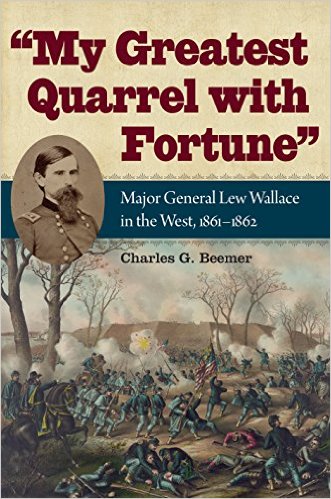Review: “My Greatest Quarrel with Fortune”: Major General Lew Wallace in the West, 1861-1862
Lew Wallace lived a life of many hats. From volunteer in the Mexican War, to lawyer, Civil War General, territorial governor where he tangled with Billy the Kid, best-selling novelist, and ambassador to the Ottoman Empire, Wallace’s biography reads like an action-packed adventure. Wallace’s pride and passion came, though, with preserving his country’s union in its bloody Civil War. He did, however, have his detractors.
Those detractors laid blame for the near-defeat at the battle of Shiloh in April 1862 with Wallace’s perceived meandering around the battlefield. Generations of historians, including Wallace’s contemporaries, have lambasted him as being lost on the battlefield—taking the wrong road and thus arriving at the end of the first day’s grisly action. It was an accusation that Wallace fought to his dying day. Recently, though, Wallace has received support from modern historians. The newest to step to the plate to bat for the defamed general is Charles G. Beemer.
Beemer’s biography of Wallace in the first year of the war is a strong defense of Wallace’s actions. Before descending into the controversies and mix-ups of the battle of Shiloh, Beemer first introduces the reader to Wallace’s childhood and early Civil War service. Losing his mother at a young age and with a father involved with Indiana politics, Beemer explains, Wallace developed into “an independent, self-reliant, and self-absorbed spirit” (16). Wallace would rely on that independence and self-reliance, for good or bad, throughout his life, and it is impossible to understand the Hoosier general’s decisions during the Civil War without this background.
From Wallace’s childhood, Beemer explains Wallace’s early Civil War experience as colonel of the 11th Indiana Zouaves, actions at Romney, West Virginia, and then, the decisive actions at Fort Donelson. Commanding a division for the first time at Fort Donelson in February, 1862, it fell to Wallace to march to the endangered right flank of the Federal army without orders—an example of the self-reliance from his childhood.
The battle of Shiloh and the ensuing controversies take up, rightly, the lion’s share of the book. In this controversy, Beemer pits Wallace against U.S. Grant, his aides, and Henry Halleck. Beemer lays blame for some of the Federal army’s surprise on Halleck and a “mind-numbing caveat” to not offensively engage the rebel forces without reinforcement (121).
When it comes to Grant and his aides, Beemer shows that Grant held himself at an arm’s length from the infighting with Wallace, instead relying on three aides (John Rawlins, William Rowley, and James McPherson) to argue in reports and the papers with Wallace. This fighting is characterized as a “cover up”: efforts by the different aides to assert that Wallace took the wrong road to the battle (206). Beemer writes with authority that these aides, and Grant himself, were incorrect, and Wallace did everything in his power to get to the battlefront and that through the aides’ writing, they “did irreparable damage to Wallace’s relationship with Grant” (230).
Wallace, however, was not unassailable in all regards, as Beemer makes clear in what is probably the book’s strongest attribute. It would be too easy to paint Wallace as the victim slandered and libeled, as he innocently tried to clear his name. Instead Wallace’s main fault was that the man never knew when to keep his mouth shut. “Virtually on his own,” Beemer writes in the book’s conclusion, “with unrestrained self-assurance and unfettered arrogance, Wallace did more than enough by himself to achieve Halleck’s objective of ridding his army of at least one civilian amateur” (240). This conclusion, added to the book’s equally strong introduction with such damning statements as “Wallace was a victim at Shiloh… a victim of his own arrogance and inflated sense of self-importance” do more than enough to prove Beemer’s point that yes, Halleck and Grant were antagonist, but Wallace did more than enough on his own to hurt his character’s standing.
This study of Wallace is a vital asset for anyone who wants a glimpse into the general’s life and service, as well as a student of the Western Theater’s early operations. It should take a well-deserved spot on most bookshelves.
“My Greatest Quarrel with Fortune”: Major General Lew Wallace in the West, 1861-1862 by Charles G. Beemer
(Kent State University Press, 2015)
248 pages main text; 330 pages total
Endnotes, Bibliography, Index


Nice to see a biography on this interesting American. I think part of the conflict in his best-seller (Ben Hur) came from his own life and the accusations against him during the CW. (BTW, I like the novel even better than the classic movie.)
Really good. This is what I believed about Shiloh. Recently read Ben-Hur. Much better than the movies!
Thanks for commenting Sarah and Joe. While there are some people who believe Wallace based “Ben-Hur” on his war experiences, Wallace’s preeminent biographer, Gail Stephens, isn’t so convinced. I personally believe that every writer, from the greats to the mediocres, are influenced at least partially by their own life stories; they have to be– it’s what sets everyone apart. So I do believe Wallace took some of his experience (not just from the CW, but his own, hectic, adventurous journey) and put them into the book– but I don’t think you can go through his pages and make a point to point comparison. (However, I do think Wallace would have very much enjoyed if Henry Halleck died in a painful chariot crash.)